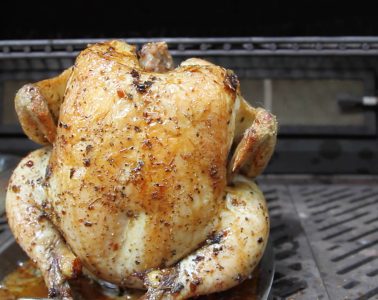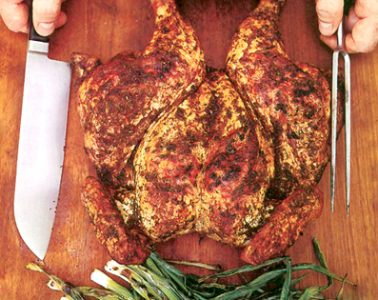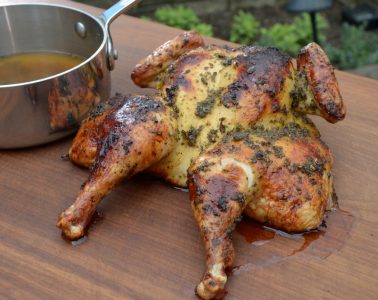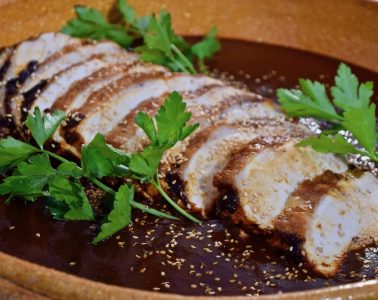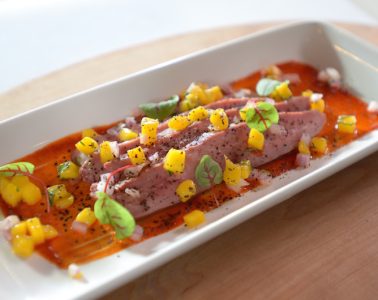Pollo a la Leña
If you don’t have a rotisserie, you can use the same approach with 2 vertical roasters (the ones that emulate “beer can” chicken roasting). Because the chicken is brined, there’s no need to sprinkle it with salt after you carve it. But it’s delicious with a sprinkling of roughly chopped or torn fresh herbs. And roasted tomato salsa!
Makes enough for 6 to 8 servings
From Season 9, MexicoOne Plate At A Time
INGREDIENTS
- 1 cup (10 ounces) fine-ground sea salt
- 4 ounces (1 medium cone or 2 small cones) piloncillo (Mexican unrefined sugar), roughly chopped OR 2/3 cup packed dark brown sugar
- 2 tablespoons pure powdered ancho chile
- 1 whole, unpeeled head of garlic, cut in half around the equator
- 1 12-ounce bottle dark Mexican beer (Negra Modelo is perfect here)
- 2 whole chickens (“roasters” that are about 4 pounds each), giblets removed if there are any
- 6 tablespoons butter
- 3 large garlic cloves, peeled and finely chopped
INSTRUCTIONS
- The brine. Measure 1 quart of water into a large saucepan, stir in the salt, sugar and powdered chile. Add the garlic and set the pan over high heat. When the mixture comes to a boil, take it off the heat and stir until the salt and sugar are completely dissolved. Pour into a vessel large enough to hold the two chickens: a 12-quart stock pot, a clean dish pan, a deep vegetable or meat drawer from your refrigerator. Add the beer and 2 ½ quarts cold water. Slip the chickens into the brine; if necessary weight them with a heavy plate to keep them submerged. Refrigerate for 4 to 5 hours.
- Prepare the spit and grill. Turn on a gas grill to medium or light a charcoal grill and let the coals burn until medium hot and covered with grey ash. Remove the chickens from the brine and pat them dry—inside and out—with paper towels. Tie their legs together and twist the wing tips (the final wing joint) up and over to the bird’s back, to keep the wings securely in place. Skewer one bird on the spit through the cavity and then the breast. Skewer the second bird in reverse: through the breast and out through the cavity. The birds should fit neatly together, butt-to-butt, one with breast facing up, the other’s breast facing down. Secure the birds firmly in place with the spit forks (mine fit neatly over the breasts of most birds without piercing them).
- Spit-roasting. If you’re using a charcoal fire, bank the coals to the sides, so that they’re not directly under the spit. If it’s possible on your grill, turn off the gas that’s directly under the spit. Otherwise, you’ll want to check the chickens frequently while they’re cooking, lowering the temperature as needed so that the chickens cook slowly to a perfect doneness.Connect the spit, start the spinning and cover the grill (if that’s possible on your grill). As the chickens cook, melt the butter in a small saucepan over medium heat. Add the garlic, stir for a minute or so, until it begins to turn golden, then remove the pan from the heat. Every ten minutes use a brush to baste the birds with the garlic butter. When the temperature of the thickest part of the thigh reaches 150 to 160 degrees (depending on the degree of doneness you like), the chickens are ready—that will take about 45 minutes, depending on the heat of your grill.
- Carving the chickens. Cut each chicken into serving pieces: Cut the leg-and-thigh portions from each side, slicing down through the joint that connects them to the backbone. Then slice through the joint that connects the legs to the thighs. Transfer to a warm serving platter. With the remaining chicken breast-side up on cutting board, slide your knife inside the cavity and cut straight down through the tiny ribs on each side to the backbone. Remove the backbone (it doesn’t have a lot meat on it). Cut right down through the breast (once the chicken is cooked, this is easier than it sounds), then cut each breast portion in half. Pile everything on the platter, sprinkle with herbs and serve with salsa.
